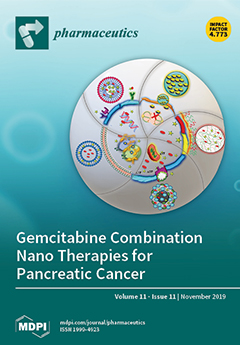Introduction: Transarterial radioembolization (TARE) has been proven as an effective treatment for unresectable liver tumor. In this study, neutron activated,
153Sm-labeled microspheres were developed as an alternative to
90Y-labeled microspheres for hepatic radioembolization.
153Sm has a theranostic advantage as it
[...] Read more.
Introduction: Transarterial radioembolization (TARE) has been proven as an effective treatment for unresectable liver tumor. In this study, neutron activated,
153Sm-labeled microspheres were developed as an alternative to
90Y-labeled microspheres for hepatic radioembolization.
153Sm has a theranostic advantage as it emits both therapeutic beta and diagnostic gamma radiations simultaneously, in comparison to the pure beta emitter,
90Y. Methods: Negatively charged acrylic microspheres were labeled with
152Sm ions through electrostatic interactions. In another formulation, the Sm-labeled microsphere was treated with sodium carbonate solution to form the insoluble
152Sm carbonate (
152SmC) salt within the porous structures of the microspheres. Both formulations were neutron-activated in a research reactor. Physicochemical characterization, gamma spectrometry, and radiolabel stability tests were carried out to study the performance and stability of the microspheres. Results: The Sm- and SmC-labeled microspheres remained spherical and smooth, with a mean size of 35 µm before and after neutron activation. Fourier transform infrared (FTIR) spectroscopy indicated that the functional groups of the microspheres remained unaffected after neutron activation. The
153Sm- and
153SmC-labeled microspheres achieved activity of 2.53 ± 0.08 and 2.40 ± 0.13 GBq·g
−1, respectively, immediate after 6 h neutron activation in the neutron flux of 2.0 × 10
12 n·cm
−2·s
−1. Energy-dispersive X-ray (EDX) and gamma spectrometry showed that no elemental and radioactive impurities were present in the microspheres after neutron activation. The retention efficiency of
153Sm in the
153SmC-labeled microspheres was excellent (~99% in distilled water and saline; ~97% in human blood plasma), which was higher than the
153Sm-labeled microspheres (~95% and ~85%, respectively). Conclusion:
153SmC-labeled microspheres have demonstrated excellent properties for potential application as theranostic agents for hepatic radioembolization.
Full article






